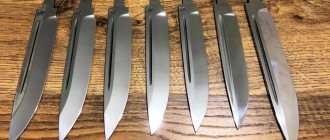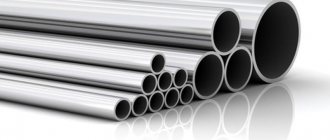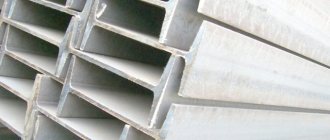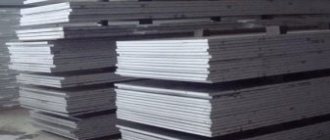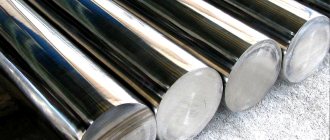Characteristics of steel grade 60PP
Steel 60PP is a structural high-quality carbon steel, not used for welded structures. CTS followed by heat treatment.
Not prone to flake sensitivity, no tendency to temper brittleness. Machinability in a normalized state. Various parts are manufactured from 60PP steel by hot upsetting, upset, stamping, hot forming or cold machining; automotive parts.
Sheet steel K60
Rolled thick sheet K60 TU 14-1-5474-2009 from low-alloy steel is used for the manufacture of electric-welded straight-seam gas pipes for operating pressures up to 9.8 MPa inclusive.
BMK STEEL LLC sells sheets of steel grade K60 from a warehouse in Chelyabinsk. Sheets are supplied from stock in thicknesses from 8 to 50 mm.
If you have specific requirements for metal products, send your application on letterhead. The company's specialists will respond in writing about delivery times, capabilities and prices for metal products.
If you have questions about purchasing K60 steel grade or its equivalent, you can contact us by phone +7. This email address is being protected from spambots. You must have JavaScript enabled to view it. .
Interpretation of steel grade 60PP
Interpretation of steel: Structural high-quality carbon steels are produced in converters or in open-hearth furnaces. The designation of these steel grades begins with the word “Steel”. The next two numbers indicate the average carbon content in hundredths of a percent; the numbers 60PP indicate its content of about 0.6 percent. The letters PP indicate hot rolling technology: longitudinal rolling consists of the fact that the strip is brought to rolls rotating in different directions and pulled into the gap between them due to friction forces on the contact surface. The strip is compressed in height and takes the form of a gap (caliber) between the rolls. With this rolling method, the strip moves only forward, that is, it only makes translational motion. Depending on the calibration of the rolls, the shape of the cross-section and longitudinal section of the rolled product may be different. the body being processed (cylindrical in shape) is placed in the gap between two rollers rotating in one direction and receives rotational motion due to friction forces on the contact surface. Body deformation occurs when the rolls approach each other. The body being processed does not move in the longitudinal direction (unless there are special pulling devices). Cross rolling is used for the manufacture of shafts, axles, and bushings.
Chemical composition in % of steel 60G and GOST standards for rental
The alloy of this grade has a relatively high carbon content, as well as manganese as the main alloying element:
- Fe – about 97%
- C – 0.57-0.65%
- Mn – 0.7-1%
- Si – 0.17-0.37%
- Ni – no more than 0.25%
- Cr – no more than 0.25%
- Cu – no more than 0.2%
- S – no more than 0.035%
- P – no more than 0.035%
60g steel enters the workshops of industrial enterprises in the form of shaped long products, manufactured in accordance with GOST standards:
- GOST 1051-73, 7417-75, 8559-75 and 8560-78 – calibrated rods
- GOST 14955-77, 7419.0-78 and 7419.8-78 – ground rods and silver
- GOST 1577-93 – thick sheets
- GOST 2283-79 – tapes
- GOST 4405-75 and 103-2006 – stripes
- GOST 1133-71 – forged blanks and forgings
Steel grade K60 interpretation:
K60 means steel with strength class K60; it includes the following steel grades: 10G2FBU 10G2FB 10G2SB 10G2SFB 08G1NFB 08G1NFB 09GNFB
Delivery of sheets 16D, 15HSND, 10HSND GOST 6713-91 by special transport:
Sheet K60 10mm, 12mm, 16mm, 20mm, 25mm, 32mm, 40mm, 45mm, 50mm delivery to Surgut:
Sheet K60 12mm, 14mm, 18mm in Omsk:
Sheet K60 12mm, 14mm, 18mm in Omsk:
Source
Brand: steel, metal 60G
Brand: 60G
| Brand: | 60G |
| Substitute: | 65G |
| Classification: | Structural spring steel |
| Application: | flat and round springs, springs, spring rings and other spring-type parts that require high elastic properties and wear resistance; tires, brake drums and bands, brackets, bushings and other parts of general and heavy engineering. |
| Foreign analogues: |
| C | Si | Mn | Ni | S | P | Cr | Cu |
| 0.57 — 0.65 | 0.17 — 0.37 | 0.7 — 1 | up to 0.25 | up to 0.035 | up to 0.035 | up to 0.25 | up to 0.2 |
| Ac1 = 726, Ac3(Acm) = 765, Ar3(Arcm) = 741, Ar1 = 689, Mn = 270 |
| Weldability: | not applicable to welded structures. |
| Flock Sensitivity: | insensitive. |
| Tendency to temper brittleness: | inclined. |
| Assortment | Size | Eg. | sв | sT | d5 | y | KCU | Thermal change |
| — | mm | — | MPa | MPa | % | % | kJ/m2 | — |
| Rolled products, GOST 14959-79 | 980 | 785 | 8 | 30 | Quenching 830oC, oil, Tempering 470oC, | |||
| Cold-worked tape, GOST 2283-79 | 740-1180 | |||||||
| Annealed tape, GOST 2283-79 | 640-740 | 10-15 |
| Hardness 60G without heat treatment, GOST 14959 | HB 10 -1 = 285 MPa |
| Hardness 60G heat-treated, Rolled GOST 14959-79 | HB 10 -1 = 241 MPa |
| Hardness 60G normalized, thick sheet GOST 1577-93 | HB 10 -1 = 269 MPa |
| Hardness 60G after annealing, thick sheet GOST 1577-93 | HB 10 -1 = 229 MPa |
| T | E 10- 5 | a 10 6 | l | r | C | R 10 9 |
| hail | MPa | 1/Grad | W/(m deg) | kg/m3 | J/(kg deg) | Ohm m |
| 20 | 2.04 | 7810 | ||||
| 100 | 11.6 | 483 | ||||
| 200 | 11.9 | 487 | ||||
| 300 | 12.9 | |||||
| 400 | 13.8 | 529 | ||||
| 500 | ||||||
| 600 | 14.6 | 575 | ||||
| T | E 10- 5 | a 10 6 | l | r | C | R 10 9 |
Foreign analogues of the material
Both exact and closest analogues are indicated!
| USA | Germany | Japan | France | England | European Union | Italy | Belgium | Spain | China | Sweden | Bulgaria | Hungary | Poland | Romania | Czech | Austria | Australia | Switzerland | South Korea |
| — | DIN,WNr | JIS | AFNOR | B.S. | EN | UNI | NBN | UNE | G.B. | SS | BDS | MSZ | PN | STAS | CSN | ONORM | AS | SNV | KS |
| 1561 | |||||||||||||||||||
| G10600 | |||||||||||||||||||
| G10640 | |||||||||||||||||||
| G15610 |
| C60E |
| C61 |
| Ck60 |
| C60 |
| S65C-CSP |
| AF70 |
| C60 |
| C60E |
| C60RR |
| XC60 |
| XC65 |
| 080A62 |
| 1449-CS |
| 1449-HS |
| 60HS |
| C60 |
| C60E |
| CS60 |
| 1CS60 |
| 2CS60 |
| C60 |
| C60E |
| C60E |
| C60R |
| |||||||||||||||||||||||||||||||||||||||||||||||||||||||||||
Types of axes
Based on the shape of the head and ax head, axes are divided into universal and special. The universal ones include:
- Economic. A small ax with an almost symmetrical head.
- Army and tourist. Lightweight tools, the head and ax handle are often made from one piece of metal.
- Plotnitsky. Differs in sharpening angle for easy removal from dense wood.
- Russian. Can be used for woodworking and as a throwing weapon
Special axes are used to perform a certain type of work. Examples:
- A splitting splitter for splitting sawn logs along the grain. The head is massive and hardly sharpens.
- Myasnitsky with a short ax and a wide head.
- Lumberjack's axe. It has the longest ax handle, which increases the impact force.
- Firefighter. All-metal with a spike on the butt and heat-protective linings on the axe.
- Roofing. The butt has the shape of a hammer.
- Adze. Designed to remove layers of wood.
Main types of axes.
Hardening
Steel hardening is a heat treatment process, the essence of which is to heat steel to a temperature above the critical temperature, followed by rapid cooling. As a result of this operation, the hardness and strength of steel increase, and ductility decreases.
When steels are heated and cooled, the atomic lattice is rearranged. The critical temperature values for different grades of steel are not the same: they depend on the content of carbon and alloying impurities, as well as on the rate of heating and cooling.
After hardening, the steel becomes brittle and hard. When heated in thermal furnaces, the surface layer of products becomes covered with scale and is decarbonized the more, the higher the heating temperature and the holding time in the furnace. If the parts have a small allowance for further processing, then this defect is irreparable. Hardening modes for hardening steel depend on its composition and technical requirements for the product.
During hardening, parts should be cooled quickly so that austenite does not have time to transform into intermediate structures (sorbitol or troostite). The required cooling rate is ensured by selecting the cooling medium. In this case, excessively rapid cooling leads to cracks or warping of the product. To avoid this, in the temperature range from 300 to 200 degrees, the cooling rate must be slowed down, using combined hardening methods. The method of immersing the part in a cooling medium is of great importance to reduce warping of the product.
Rules of care
There are several rules:
- The metal surface after heat treatment is black. A layer of oxides is formed, which protects the tool from corrosion. You cannot remove blackening with grinding wheels “for beauty”. Only the working edge of the blade should shine after sharpening.
- Before long-term storage, the head is lubricated with oil. Experienced carpenters do not recommend using machine lubricants for this purpose. They use castor, linseed or vaseline oil. After lubrication, wipe the head - a thin film is enough to protect against rust.
- The tool should not lie on the ground, on a concrete floor or stand near a wall for a long time. The geometry of the ax is disrupted. That's why they hang him up. The wooden part is impregnated with oil so that the wood does not dry out.
How to sharpen an ax correctly
In production, cutting edge geometry is developed using a grinder. This is a belt sander. On an abrasive of this shape, a convex cutting edge is more easily formed.
- While working with an axe, it is enough to regularly adjust the cutting edge with a fine abrasive stone. The angle specified during sharpening in production is not violated.
- For universal axes, the sharpening angle is 20-30 degrees, for carpentry tools - 35 degrees. The steel is hard enough to hold an edge for a long time.
- If you need to restore the cutting edge and eliminate chips, use an electric sharpener. A grinder is not suitable for this purpose.
- It is very important to maintain the sharpening angle. They operate at low speeds to avoid beating of the blade and strong heating of the metal. As the temperature rises, the structure of the hardened steel changes and the blade loses its hardness.
- To cool, add water or take breaks from work.
Ax sharpening technology.
